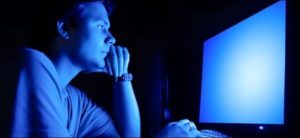 Now and then I hear people wondering whether the many hours we spend staring at computer, cell phone, and tablet screens is damaging our eyes. And what about fluorescent lighting (which seems to bother many people) and LED lights? After all, the blue light of all our device screens seems intense, and researchers have long known that blue light is toxic to the retina.
Now and then I hear people wondering whether the many hours we spend staring at computer, cell phone, and tablet screens is damaging our eyes. And what about fluorescent lighting (which seems to bother many people) and LED lights? After all, the blue light of all our device screens seems intense, and researchers have long known that blue light is toxic to the retina.
Recently researchers measured the blue light on various device screens and lamps (including over extended time periods) and compared it to looking at a clear blue sky in June (but not looking at the sun). They found that most devices put out less blue light than the blue sky on a clear day and all were less than international standards for blue light exposure limits. Whew...we're all OK. But don't use them for a long time at night because their bright emissionInternational Commission on Non-Ionizing Radiation Protectisuppresses melatonin (needed for sleep). From Medscape:
Blue Light From Screens, Bulbs Won't Damage Retina
Despite concerns that staring at devices putting out high amounts of the blue light wavelength could damage human retinas, a recent study finds that most devices put out less of that light than the blue sky on a clear day. "Even under extreme long-term viewing conditions, none of the low energy light bulbs, computers, tablets and mobile phones we assessed suggested cause for concern for public health," said lead author John O'Hagan, head of the Laser and Optical Radiation Dosimetry Group of Public Health England in Chilton, U.K., in an email.
As people are using computers and phones more often and low-energy lighting like fluorescent and LED bulbs is becoming more common, the types of light human eyes are encountering is changing, the researchers pointed out January 15 online in the journal Eye. Compared to traditional incandescent bulbs, electronic screens and low-energy light bulbs tend to emit more blue light, which has long been known to be toxic to the retina, they write.
Based on that toxicity research, the International Commission on Non-Ionizing Radiation Protection (ICNIRP) has proposed a safe exposure limit, below which blue light is unlikely to harm a viewer's eye. O'Hagan and his team measured the blue light emitted by several sources, including mobile phones, tablet computers, laptops and lamps, over time periods similar to the way people use the devices. Then they compared the emissions to the ICNIRP's exposure limits.
After comparing multiple colors on device screens, the researchers found that a white screen had the highest blue light emissions, so they used a white screen set at maximum brightness for their measurements.They also compared the blue light emissions from various devices to the levels people would encounter when looking at a clear blue sky in summertime in Chilton, in southern England, and also to an overcast winter sky in the same location.
The blue light exposure on a clear day in June was around 10 percent of the ICNIRP safe limit. A cloudy day in December produced around 3 percent of the limit. Comparing these natural exposures with light from lamps, computer screens and mobile devices like smartphones, the study team found that the artificial light produced even lower exposures than people normally encounter outdoors. That is, provided they're staring just at the sky, not directly at the sun.
Even considering that people may stare at computer screens for hours in the course of work or play, the study team concludes that there's no danger to the retina.They caution, however, that the amount of light that gets transmitted from the surface of the eye to the retina is age-related, so children may be more sensitive to blue light. Light sources that are comfortable for adults could be distressing for children, the authors warn.
